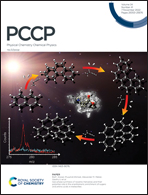Electrostatic interactions and physisorption: mechanisms of passive cesium adsorption on Prussian blue†
Abstract
The dangers posed by nuclear accidents necessitate developments in techniques for cesium removal. One such is the adsorption of cesium cations in Prussian blue (PB) materials, on which adsorption can be a substation process or pure physisorption. The underlying mechanism of the latter is not well understood, although a Langmuir isotherm is frequently used to model experimental results. In this work, we exploit tight-binding density-functional theory (DFTB) methods to probe the atomic interactions in the physisorption process. The results show that there is a diminishing return for the energy of adsorption as more sites are filled. This means that the adsorption sites are not independent, as stipulated by the ideal Langmuir isotherm. Instead, the results indicate that electrostatic effects need to be considered to explain the theoretical and experimental results. Therefore, an electrostatic Langmuir (EL) model is introduced, which contains an electrostatic ideality correction to the classic Langmuir isotherm. For future materials development, these physical insights indicate that shielding effects as well as the number of independent physical sites must be considered when synthesizing effective Prussian blue analogs (PBA). In conclusion, the study provides insights into the limiting mechanisms in the physisorption of cesium cations on PB.



 Please wait while we load your content...
Please wait while we load your content...